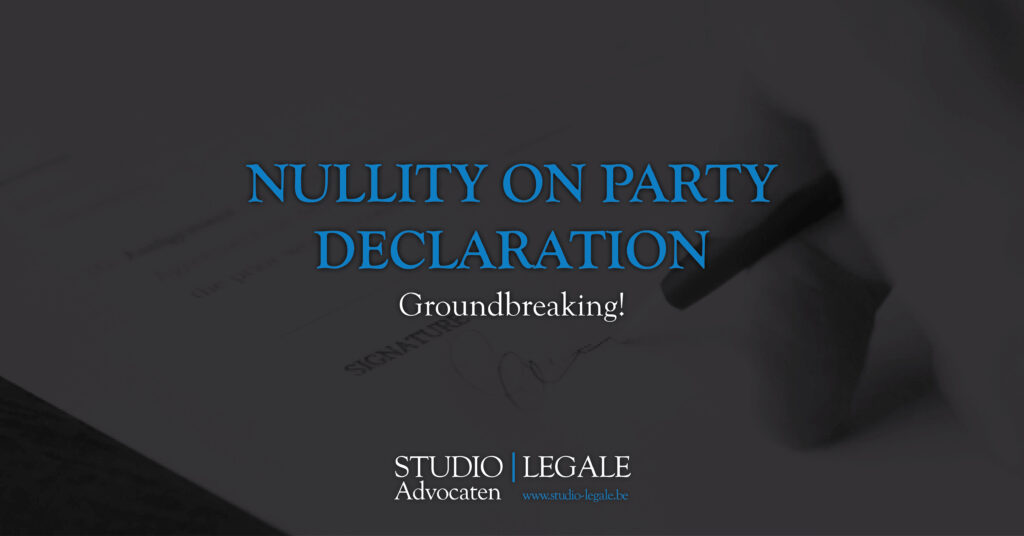
A contract that does not meet certain conditions of validity is void, or as will be shown infra, voidable. Until the entry into force of the new contract law (i.e. 1 January 2023), there were two ways of nullification: extrajudicial and judicial. The new contract law introduced a third possibility: nullity on party declaration.
Validity and nullity of a contract
There are 4 conditions of validity of a contract (article 5.27(1) of the Civil Code):
- Each party gives its free and knowing consent;
- Each party is competent to contract;
- There is a determinable and lawful object;
- There is a permissible cause.
A contract that does not meet these conditions of validity is void, or rather voidable (article 5.57(1) of the Civil Code). Indeed, nullity never takes automatic effect, so the contract continues to have effects until the contract is actually declared null and void (article 5.59, first paragraph Civil Code).[1]
Nullification could take place in two ways until recently. On the one hand, a contract could be annulled in an extrajudicial way, i.e. by mutual agreement of the parties. On the other hand, a contract could be declared void in a judicial way, i.e. after a court recognises the ground for nullity (article 5.59, second paragraph Civil Code).
Innovation: nullity on party declaration
The new contract law (in force since 1 January 2023) adds a third way, namely nullity on party declaration or notification. Here, a contract can become void by the simple declaration or notification of a party.
It seems unreasonable to oblige a party to a contract affected by a ground of nullity to wait for court proceedings before being released from the contract.[2]
The party declaration requires written notification to all contracting parties (article 5.59, third paragraph Civil Code). This notification has effect only until 5 years after the knowledge of the nullity ground or, at the latest, until 20 years after the conclusion of the contract. Thereafter, nullity by notice is time-barred (article 5.60 Civil Code).
The risk of such invalidity on party declaration always rests on the party issuing such declaration. This is because the court can always be caught a posteriori to check whether there was actually a ground for nullity and whether the notification of nullity to the contracting party was correct.
If the court finds that the contract was indeed validly formed, it can declare the notice of nullity "ineffective". This has the effect that the contract was not terminated at the time through the party declaration. If the party that gave the notice of nullity has ceased to perform its contractual obligations, this non-performance could justify termination of the contract to its detriment.[3]
Nullification on party declaration is excluded for contracts established by an authentic act such as a notarial deed or homologation judgment (article 5.59, third paragraph Civil Code). However, an extrajudicial or judicial annulment remains possible.
Consequence: retroactive and proportional nullity
The annulment retroactively (i.e. from the day of the conclusion of the contract) takes away all the effects of the contract. The services already rendered under the annulled contract then give rise to restitution, subject to compliance with the legal conditions (article 5.62 Civil Code).
However, if the ground for invalidity relates only to a severable part of the contract, the annulment is limited to that part. However, this requires that the remaining part of the contract can remain intact and that it still corresponds to the intention of the parties (article 5.63, first paragraph Civil Code).[4]
Finally, it should be emphasised that article 5.59(3) of the Civil Code constitutes supplementary law. This means that parties can modulate (e.g. pre-empt certain term) or completely exclude the possibility of nullity on party declaration in the contract.[5]
Do you have any questions after reading this article or would like more information on this topic? Feel free to contact the Studio Legale team on 03/216.70.70 or at [email protected].
[1] F. PEERAER en S. STIJNS, “De proportionaliteit van de nietigheid: de onwerkzaamheid of een nieuwe adem voor de onbestaanbaarheid?”, TBBR 2017/7, (374) 375.
[2] Memorie van toelichting bij het Wetsvoorstel van 24 februari 2021 houdende Boek 5 “Verbintenissen” van het Burgerlijk Wetboek, Parl.St. Kamer nr. 55, 1806/001, 68; A. DE BOECK, “Het nieuwe verbintenissenrecht”, NjW nr. 467, 5 oktober 2022, (610) 617.
[3] Memorie van toelichting bij het Wetsvoorstel van 24 februari 2021 houdende Boek 5 “Verbintenissen” van het Burgerlijk Wetboek, Parl.St. Kamer nr. 55, 1806/001, 69; S. STIJNS en S. DE REY, “Het nieuwe verbintenissenrecht in Boek 5 BW – Deel I”, RW 2022-23, nr. 24, (923) 939.
[4] A. DE BOECK, “Het nieuwe verbintenissenrecht”, NjW nr. 467, 5 oktober 2022, (610) 616; S. STIJNS en S. DE REY, “Het nieuwe verbintenissenrecht in Boek 5 BW – Deel I”, RW 2022-23, nr. 24, (923) 938.
[5] S. STIJNS en S. DE REY, “Het nieuwe verbintenissenrecht in Boek 5 BW – Deel I”, RW 2022-23, nr. 24, (923) 939.


